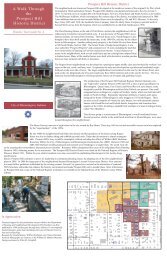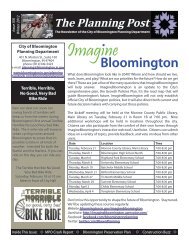Peak Oil Task Force Report - City of Bloomington - State of Indiana
Peak Oil Task Force Report - City of Bloomington - State of Indiana
Peak Oil Task Force Report - City of Bloomington - State of Indiana
Create successful ePaper yourself
Turn your PDF publications into a flip-book with our unique Google optimized e-Paper software.
Spatial & Economic Dispersion<br />
The result was the unprecedented spatial expansion <strong>of</strong> the typical community and a vast<br />
increase <strong>of</strong> the human scale. Over time, as suburbs exploded around city cores, they<br />
drained those cores <strong>of</strong> residents. Inner cities became little more than employment centers<br />
or depressed quarters for those unable, financially, to escape them. Meanwhile, the<br />
suburbs developed a new, and heret<strong>of</strong>ore<br />
unique, arrangement whereby zoning<br />
forced land use into specialized pods such<br />
as residential, employment, or retail.<br />
These pods were separated by large<br />
distances and connected to each other via<br />
highways and arterial roads. The city’s<br />
dense and redundant web <strong>of</strong> street grids<br />
gave way to the suburbs’ sparse set <strong>of</strong><br />
connectors.<br />
The automobile‐enabled diaspora’s effects<br />
are felt most acutely by lower‐income<br />
earners. Without access to low‐cost transportation, such as pedestrian travel or public<br />
transit, lower‐income workers are forced to either take on the expense <strong>of</strong> automotive<br />
ownership ($5,000 a year for an average automobile 128 ) or restrict their employment<br />
opportunities. Because lower‐income workers are more likely to own older and less fuel<br />
efficient vehicles, the effects <strong>of</strong> fuel prices are particularly problematic for these workers. If<br />
a worker must make a twenty mile round‐trip commute from her place <strong>of</strong> residence to her<br />
place <strong>of</strong> employment and her vehicle averages twenty miles per gallon, then paying for<br />
gasoline alone will consume a significant portion <strong>of</strong> her income. At $5,000 a year for<br />
vehicle ownership, a laborer working a typical 2,000 hours/year must earn $2.50 an hour<br />
128 According to the American Automobile Association.<br />
<strong>Report</strong> <strong>of</strong> the <strong>Bloomington</strong> <strong>Peak</strong> <strong>Oil</strong> <strong>Task</strong> <strong>Force</strong><br />
Source: http://planning.city.cleveland.oh.us/cwp/landuse.htm<br />
89









